Simien Mountains National Park
Simien Mountains National Park is the largest national park in Ethiopia. Located in the Northern Gondar Zone of the Amhara Region, its territory covers the Semien Mountains and includes Ras Dashan, the highest point in Ethiopia. It is home to a number of endangered species, including the Ethiopian wolf and the walia ibex, a wild goat found nowhere else in the world. The gelada baboon and the caracal, a cat, also occur within the Simien Mountains. More than 50 species of birds inhabit the park, including the impressive bearded vulture, or lammergeier, with its 3 m (10 ft)) wingspan.[2]
| Simien Mountains National Park | |
|---|---|
IUCN category II (national park) | |
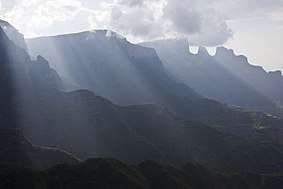 Semien Mountains | |
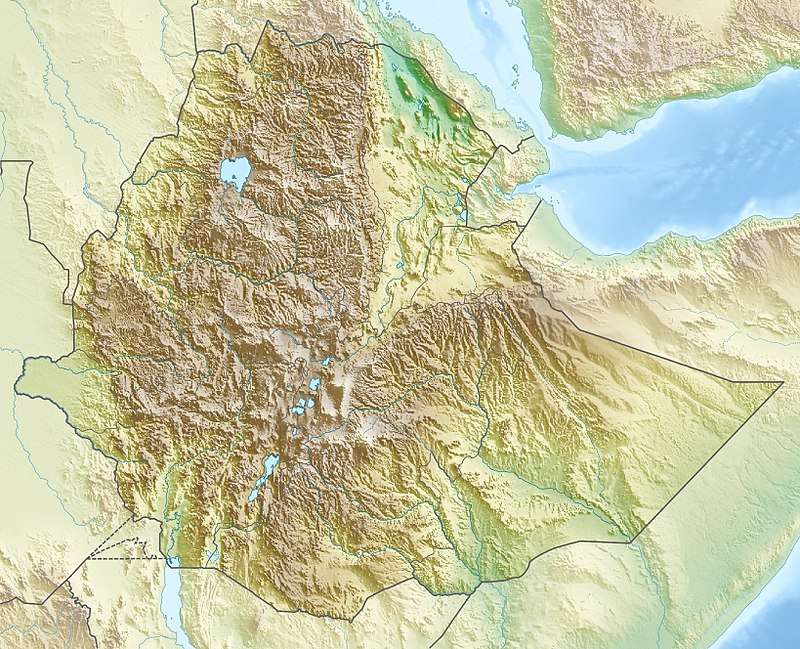 | |
| Location | Ethiopia |
| Nearest city | Debarq and Mekane Berhan |
| Coordinates | 13°11′N 38°4′E |
| Area | 220 km2 (85 sq mi) |
| Established | 1969 |
| Official name | Simien National Park |
| Type | Natural |
| Criteria | vii, x |
| Designated | 1978 (2nd session) |
| Reference no. | 9 |
| State Party | |
| Region | Africa |
| Endangered | 1996–2017[1] |
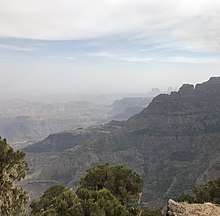
The park is crossed by an unpaved road which runs from Debarq, where the administrative headquarters of the park is located, east through a number of villages to the Buahit Pass (4,430 m), where the road turns south to end at Mekane Berhan, 10 kilometers beyond the park boundary.[3]
History
The park was established in 1969, having been set up by Clive Nicol, who wrote about his experiences in From the Roof of Africa (1971, ISBN 0 340 14755 5).
The Simien region has been inhabited and cultivated for at least 2,000 years. Initially, erosion began to reveal that the clearing began at the gentle slope of the highland valley but later expanded to a steep slope.
It was one of the first sites to be made a World Heritage Site by UNESCO (1978). However, due to serious population declines of some of its characteristic native species, in 1996 it was also added to the List of World Heritage in Danger.
Geography
Over millions of years, due to the large erosion of the Ethiopian plateau, serrated mountain peaks, deep valleys, and 1,500 meters of sheer cliffs have been created, making it one of the most spectacular scenery in the world.
The heritage area is on the western side of the Simien Mountains and is 120 km from the Gondar province of Begemder in the northwestern part of Ethiopia. The Simien area is rich in perforated basalt, and serves as an ideal catchment basin. Water is reserved by the Mayshasha River, which runs through the two rainy days and the national park from north to south. As a result, national parks are abundant with wildlife and plants.
Flora and fauna
The vegetation is mixed with African alpine forests, wilderness forests and alpine vegetation. High altitude areas include montane savannah and tree heath (Erica arborea), giant lobelia (Lobelia rhynchopetalum), yellow primrose (Primula verticillata), everlastings (Helichrysum spp.), A lady's mantle (alchemilla), and a moss (mosses, Grimmiaceae). Lichen covers the trees of the alpine area. Vegetation throughout the park is divided into three sections, Montane forest (1900-3000m), Ericaceous Belt or SubAfroalpine (2700-3700m) and the Afroalpine (3700-5433m). Within the Montane forest there are Juniper trees (Juniperous procera), African Redwood (Hagenia abyssinica), African Olive (Olea africana), Fig Trees (Ficus spp), and Waterberry Trees (Szygium guineense). There are also many varieties of shrubs including Nightshade (Solanum sessilistellatum), Abyssinian rose (Rosa abyssinica), Cowslip (primula verticillata), and Stinging Nettle (Urtica).[4] The ridges and canyons have scattered meadows, forests and bushes. At one time, the St. John's wort (Hypericum spp.) Forests grew from 3,000 m to 3,800 m above sea level, but now it is almost gone. The exact number is not known.
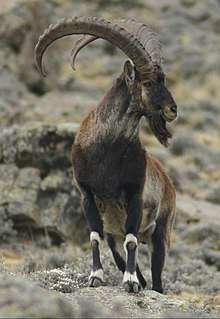
The park is populated with over 130 bird species and over 20 large mammal species[5] such as gelada baboon (Theropithecus gelada), Ethiopian wolf (also called Simen fox, Canis simensis), Walia ibex (Capra walie), wild mountain goats and the Anubis baboon.[6] Inhabits on the slope of the northern slope of massif are mostly native to the Semien Mountains, and most of them are found in the park. The Ethiopian wolf is endemic to Ethiopia and other mammals include hamadryas baboon, colobus monkey, leopard, caracal, wild cat, spotted hyena and golden jackal. There are also large herbivores, such as bushbuck, common duiker, and klipspringer.
The 400 species of birds include lammergeyer, Verreaux's eagle, kestrels, vultures, lanner falcon (Falco biarmicus), African buzzard (augur buzzard) and thick-billed raven. A total of 21 species of mammals, 3 species of endemic species, 63 species of birds and 7 species of endemic species are recorded.
Conservation
It was established as a national park in 1969 and is protected under the National Reserve Act. Current heritage requires effective management. The number of management staff should be increased and education should be strengthened. The management of national parks effectively protects the representative species of parks and works closely with local residents to reduce the pressure on park resources by expanding arable land, overfishing livestock, and overcapacity of natural resources. Due to global climate change, pressure on heritage sites is growing.
Sufficient financial support is needed for park management and livelihood alternative development of local residents. It is necessary to prepare, implement, review and monitor the management plan, to revise and expand the boundary of the park, and to participate fully in the local residents. Local cooperation is particularly important to prevent sustainable use of national park resources and to develop sustainable livelihoods. Adequate financial support for resettlement of inhabitants in the heritage area and the introduction of effective livestock management are essential to reduce the severe stress on wildlife.
In order to maintain excellent universal values, environmental education and training programs of residents living in and out of the heritage are needed as well as obtaining the cooperation and support of local residents in heritage management.
Gallery
 Semien Mountains
Semien Mountains

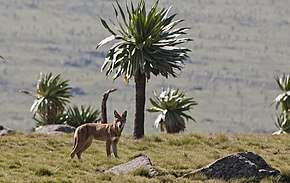
 Lobelia rhynchopetalum
Lobelia rhynchopetalum.jpg) Bird of prey
Bird of prey
 Cliff in the National Park
Cliff in the National Park
See also
- National parks in Ethiopia
- List of World Heritage Sites in Ethiopia
References
- Ethiopian World Heritage site, Simien National Park no longer in danger at UNESCO website (4 July 2017)
- WordTravels Ethiopia Travel Guide, Retrieved on June 22, 2008
- Philip Briggs, Ethiopia: The Bradt Travel Guide, 5th edition (Chalfont St Peters: Bradt, 2009), p. 240
- "Simien plants".
- "Simien National Park". UNESCO.
- "Relationship between Topographic Variables and Land Cover in the Simen Mountains National Park, a World Heritage Site in Northern Ethiopia" (PDF).
External links
| Wikivoyage has a travel guide for Simien National Park. |
| Wikimedia Commons has media related to Simien Mountains National Park. |
- UNESCO World Heritage profile of Simien National Park
- United Nations Environment Programme: World Conservation Monitoring Centre: Simien National Park
- The National Parks of Ethiopia: Simien Mountain Adventure - Part I (Addis Tribune)
- The National Parks of Ethiopia: Simien Mountain Adventure - Part II (Addis Tribune)
- The National Parks of Ethiopia: Simien Mountain Adventure - Part III (Addis Tribune)